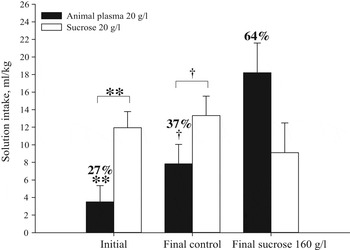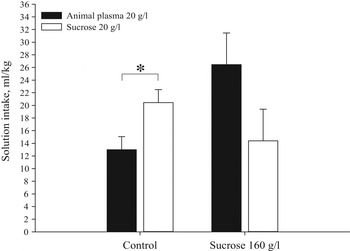There is a general concern about the negative impact of a long-term consumption of caloric drinks in kids. Adult rats become obese when they are exposed to a concentrate sucrose solution as a supplement to their diet( Reference Ackroff and Sclafani 1 ). However, it may differ when the animal is still growing. Growing pigs were used in the present study as a model for humans due to anatomical and functional features( Reference Roura, Humphrey and Klasing 2 ), as well as their innate sweet preference and growth potential. The aim was to assess the effect of a long-term sucrose solution exposure on the body weight gain and on the preference and appetence of piglets for sweet over protein solutions.
A total of 36 post-weaned piglets (42 days old) were distributed according to body weight (BW) into 12 pens (3 piglets/pen) and fed with a commercial weanling diet. The preference of piglets for protein (animal plasma 20 g/l) or sweet (sucrose 20 g/l) solutions was assessed by using a choice test before (initial, day 14 post-weaning) and after (final, day 26 post-weaning) an ad libitum supply of water (control) or 160 g/l sucrose solution for 12 consecutive days. A one-bottle test was performed thereafter by offering the same protein/sweet solutions on alternate days as a measure of their appetence. Pig performance and solution intake were also monitored. Data was analyzed with ANOVA, and preference values were compared to the neutral value of 50% by using a Student's t-test.

Figure 1. Choice test.

Figure 2. One-bottle test.
Piglets innately had a higher 20 g/l sucrose intake (clasps, †P<0.1, **P<0.01, Figure 1) and preferred (numbers on top of the bars, †P<0.1, **P<0.01) sucrose solution in the initial choice test. A higher (P<0.05) 160 g/l sucrose solution intake (1292 ml/day) in comparison with water intake (762 ml/day) was observed during the exposure period. Low feed intake and weight gain (P<0.01) were observed for piglets with access to sucrose (202 g BW gain/day) than control piglets (325 g BW gain/day). After solution exposure, sweet over protein preference was maintained in control piglets, and a higher appetence (P<0.05, Figure 2) for the sweet solution was observed in these animals. On the other hand, piglets with access to 160 g/l sucrose showed a preference for the protein solution (64%; P=0.21) and a clear reduction on the appetence for sweet solution (P=0.12). These results show that a long-term exposure to a high concentration sucrose solution depress feed intake and growth rate and also increase the desire for protein in weanling piglets.



